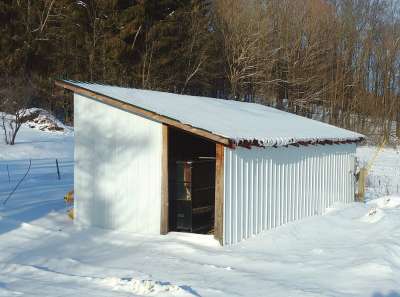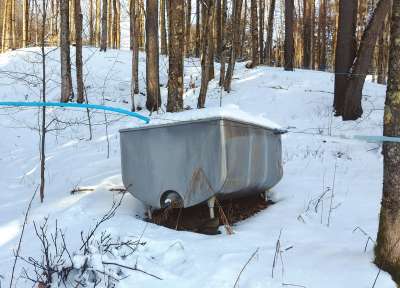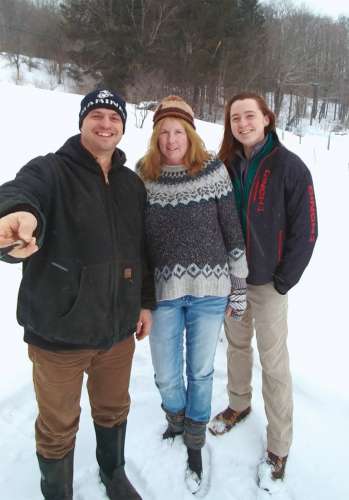
We moved to Georgetown, New York, in 1999 after I was discharged from the Marine Corps. A family member had purchased property there but was living in another state; he wanted a caretaker and someone to assist with the restoration of the house. We liked the quiet area and views of the valley, and in 2013, we were able to purchase the 173-acre property that we had been living on. We then needed a plan for the property to generate income to pay the taxes and heat the house once we retired.
In 2015, a local sugarmaker asked about the potential of leasing our woodlot. I was excited about the possibility; I have a full-time off-farm job and I saw this as a way to make a portion of the property productive without my time or resources being required. But my wife, Teresa, was concerned about the forest and changes that might occur with someone working in our woods. It took about 18 months of talks, education, and reassurances that the forest would remain as untouched as possible. The sugarmaker did a lot of work on his end to make sure Teresa was satisfied about what was going to happen in the sugarbush. Everything was spelled out in detail in a lease agreement with the sugarmaker.
We made sure that the lease included language covering the things that were important to us, such as stipulations that no trees could be cut down or damaged. If a tree needs to be removed due to storm damage, the sugarmaker must notify us beforehand. There are several four-wheeler roads that I wanted left clear, as well. During initial talks, the sugarmaker proposed a per-tap price; when the lease was signed, he actually offered 25 cents more per tap than the original quote. The sugarmaker had no real stipulations other than the sugarbush could not be used as pasture for livestock. He had a generic, fill-in-the-blank-type sugarbush lease and was willing to change any wording we didn’t feel comfortable with. The lease we signed is for 12 years.
Other than access to the sugarbush, really the only thing that we needed to provide for the sugarmaker was a spot for him to put a small building for his collection tank and vacuum system. The sugarmaker supplied all the materials and had a separate power line run for this building. I do plow snow to allow him access to the building, but that spot has always been part of my normal snowplowing area anyhow. If I’m in the woods and happen to see downed limbs or a line that needs to be fixed, I’ll help out, but the lease doesn’t require this of me. We’ve found that the sugarmaker has been respectful of the land, animals, and my family. For example, he makes sure that he stays away for a period before and during hunting season, so my deer hunting is not disturbed.
My advice for anyone interested in leasing their land is to begin by making sure you know who you are leasing to and what they want to use the land for. Talk to them about what you expect and don’t expect from them. Always question things you don’t understand, or if something seems funny or out of place. Do not sign anything until you are completely satisfied with the language of the lease. And if you don’t already, periodically inspect the land once you have leased it.
Separate from the lease of our sugarbush, I am experimenting on my own with the production of birch syrup. I had been aware of birch syrup for some time, and while walking the sugarbush with the sugarmaker, I noticed there were a lot of birch trees, so I basically said to myself “let’s see what happens.” Birch syrup is a lot different than maple – it’s more fructose than sucrose, for one, and it takes a lot more sap to make a gallon of syrup: about 100:1 versus 40:1. The sap comes later – starting around the time maple sap ends and running until the leaves come out, a timeframe that lasts about three weeks at most. Otherwise, it follows much of the same production process as maple syrup.
Most of my experience has been trial and error. I have learned that you can easily scorch the sap/syrup during boiling – something I’ve done two years in a row now. I have already had lots of interface with the sugarmaker on advice related to boiling, equipment, pails versus tubing, and sanitization. This past year, I even struck a deal with a different, small-time sugarmaker nearby to use his evaporator once he was done with maple. My system is small, about 75 to 80 taps, and I collected approximately 500 gallons of sap this past year. If successful, I have the potential to expand up to 200 taps. If done correctly, this would mean producing only about five gallons of syrup. But because birch syrup is typically sold in 8.5 ounce bottles priced at $25 to $30 (equating to $350 to $400 a gallon), a small amount can yield a big return.
Our other long-term plans include growing hemp, possibly increasing the number of hops and berry bush plantings we currently have, and growing more of our own food, both vegetables and meat. If these and the syrup endeavors are successful, it could lead into an agritourism business.



